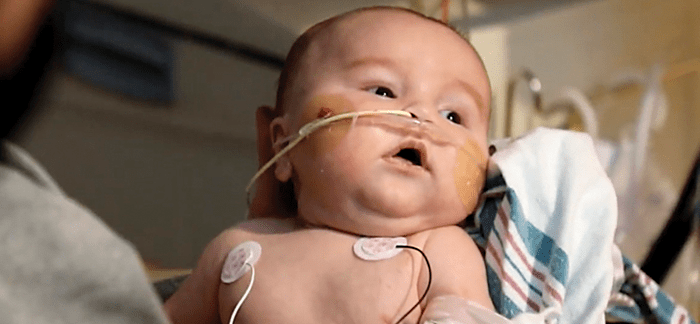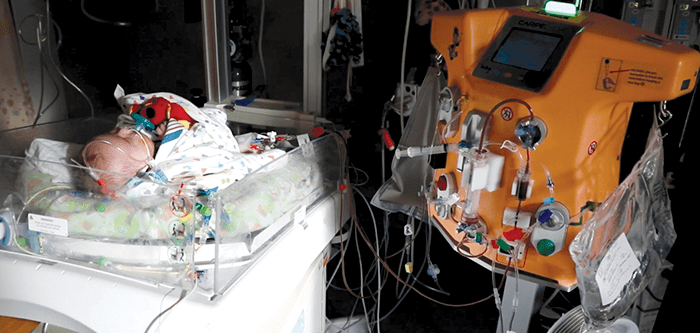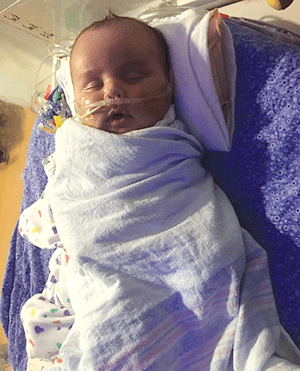Seize the Day, Save a Life
As the first in the nation to offer a new life-saving device called CARPEDIEM, we’re revolutionizing care for our smallest patients.
Bringing a new life into the world carries a wealth of worries and challenges for any parent—especially during a global pandemic.
Kayla and Isiah faced even greater uncertainty when they learned their growing baby had health concerns before he was even born.
Their beautiful boy Brenden entered the world with stage 5 chronic kidney disease. This advanced stage meant that his kidneys were failing him. He was placed on dialysis at his home hospital in Lexington, Kentucky, to help rid his body of the toxins and excess fluids that his kidneys couldn’t filter.
After two months of treatment, Brenden’s condition took a turn for the worse. He developed an infection in his abdomen, and his little body was overloading with fluid, putting his heart and other organs at risk.
“His eyes were completely shut.” Kayla remembers the moment vividly. “He couldn’t open them because there was so much built-up fluid in his little face. We hardly recognized him.”
Brenden needed a more specialized treatment right away, but because of his small size, the dialysis machines at his home hospital—made for bigger kids and adults—weren't able to help him. Thankfully, his care team could turn to the only hospital in the nation at that time treating patients with a new device designed for infants with acute kidney disease: Cincinnati Children’s.
Revolutionizing Pediatric Medicine with Bold New Advances
Brenden’s condition was critical when he arrived at our Pediatric Intensive Care Unit (PICU), but his parents held onto hope, knowing that he was where he needed to be.
The new device that would help their baby is called CARPEDIEM, which stands for Cardio-Renal Pediatric Dialysis Emergency Machine. As a leader in acute kidney care innovation, we were the first in the country to offer the life-saving machine, specifically designed for babies between 5 and 20 pounds.
“All of the previously marketed technology is made for larger patients,” says Stuart Goldstein, MD, director of our Center for Acute Care Nephrology and clinical consultant in the development of CARPEDIEM. “Dialysis machines designed for adults can expose babies to many risks—but this new system is built specifically for small infants, enabling increased precision.”
Our pursuit of bold innovation is just one of the reasons families and other hospitals turn to us for life-saving care. We’re constantly working to discover groundbreaking technology that will enhance treatments, provide cures and improve outcomes for our sickest and most fragile patients.
It’s also why we expanded the PICU in our new Critical Care Building (CCB). The updated space is designed to allow us to be more nimble and flexible in adopting new technology and care advancements, like CARPEDIEM, so that even more kids can get the specialized therapies they so urgently need.
“When Brenden came to us, he was close to twice his true weight with fluid overload, and within a week or so we were able to slowly and safely remove that,” says Dr. Goldstein. “This new device saved his life.”
Philanthropy Improves Outcomes for Our Most Fragile Patients
Thanks to donors who support cutting-edge ideas, we can better meet the needs of families near and far who turn to us in their darkest moments. Help from charitable partners allows us to provide the best care possible for the most critically ill children.
Partners like Patty and John Estep, who gave a gift to support our CCB.
Patty, one of our customer service representatives, holds a community event with her family each year to raise funds for the medical center. Most recently, they dedicated these funds to the new building, which provides 249 state-of-the-art private rooms for our most complex patients and transforms how families experience our care.
The Esteps give to remember and honor their daughter Allison, who passed away unexpectedly at just 25 years old from a rare viral infection that attacked her heart
“Allison would be so happy that we keep her memory alive by giving back to Cincinnati Children’s,” Patty says. “She was a very caring, bright and giving young lady, and we’ll continue to honor her while also helping other critically ill children receive the best care possible.”
Patty and John know that their daughter cared deeply about making a difference for the kids and families who count on us. Allison worked as a manager in Innovation Ventures, our center that plays a key role in facilitating the translation of discoveries into improved clinical care for children.
Their generous support for the CCB will help ensure that we have the space we need for the latest treatments and devices, as well as dedicated space for families who have to spend weeks, months or even years in the hospital while their child receives care.
“Philanthropy allows us to give children with rare and complicated diseases the best chance,” Dr. Goldstein explains. “Not only of surviving their acute and chronic illness today, but also a chance to thrive in the future.”
Transforming Care—Now and in the Future
Today, Kayla and Isiah look back on the time Brenden spent at Cincinnati Children’s with gratitude for the love and support his care team provided.
“We couldn’t always be at the hospital with Brenden because we live far away and have two other young children who needed us,” Kayla says. “But his caregivers made us feel like we were there. They even sent us photos of him after he was well enough to have his tubes removed. It was the first time we got to see his whole face, and it was a really special moment.”
Today, Brenden is a happy, thriving 1-year-old who has a smile for everyone he sees. For now, he’s on medication for his condition, but when he gets older, he will need a kidney transplant. Once again, his parents will travel here, entrusting us with that delicate and specialized care.
“If it wasn’t for Cincinnati Children’s, Brenden wouldn’t be alive today,” Kayla remarks. “We’ll always be grateful.”
For more information on how you can support our research innovation, please contact Lauren Bosse at 513.803.0639 or lauren.bosse@cchmc.org.






